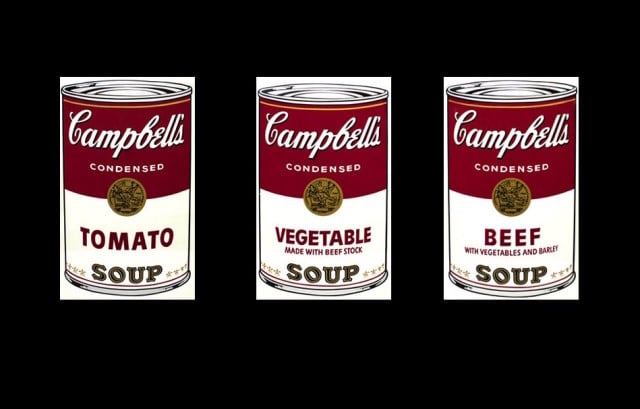Opinion
The Truth About the Stolen ‘Pop Icons’ by Andy Warhol
THE DAILY PIC: The late Soup Can prints weren't icons, or Pop ... or precious.

THE DAILY PIC: The late Soup Can prints weren't icons, or Pop ... or precious.

Blake Gopnik

THE DAILY PIC (#1530): As most news junkies have heard by now, seven of Andy Warhol’s “iconic” “paintings” of Campbell’s soup cans, estimated as being worth a $500,000 “fortune”, were recently stolen from the Springfield Art Museum in Missouri, which thereby lost some “rare” “masterpieces” of “Pop Art”. I got the images for today’s Pic from the FBI Web site, where a reward of $25,000 is on offer.
Sorry for all the scare quotes in the above paragraph, but they were needed to show how many of the “known facts” in the case are wrong. First of all, despite headlines in mainstream news outlets such as the Guardian, Daily News, MSN.com and CBS news, the stolen works weren’t paintings at all, but silkscreen prints, and not very rare ones at that: They were produced in an edition of 250. Hardly “ ‘claim to fame’ types of pieces,” which is how the Springfield police described them to the New York Times. That is why they are worth at very most the piddling sum of maybe $30,000 each ($500,000 would the maximum price for a full set of 10, and a broken set would fetch much less). That is, they cost less than you might pay for a piece of zombie abstraction by some kid painter fresh out of grad school.
If the stolen works were really from the series of truly iconic Campbell’s soup paintings that shot the unknown artist to fame in 1962, they’d be worth something like $10 million each – but those canvases will never come up for sale (or, one assumes, for theft) since all 32 of them are safely stowed away in the permanent collection of the Museum of Modern Art in New York.
The stolen prints are utterly different, even in look, from the hand-painted pictures at MoMA, which I’ve written about at rather great length. The prints are slick and hard-edged and quite faithful to the real soup packaging; the original paintings Warhol derived them from have lots of rough edges and weirdnesses, as well as a much more complex, idiosyncratic relationship to their supermarket sources.
The main reason for the difference is that the stolen prints were published in 1968, when Warhol had long since dropped his practice as a Pop artist in favor of underground films and all kinds of experimental art making: He offered to endorse any and every product, and count that as art; he designed rain and snow machines – again, as art. The year the soup-can silkscreens went on the market, Warhol was in fact stuck in a fallow moment and not sure where to head next – and then half-way through that year he was shot, setting his art back even further. Once he recovered, he found a way forward with what he went on to call “business art”, whereby the simple (or not so simple) act of earning money as an artist would be his new medium. His art would be all about commodifying his own hand and brand, and turning them into the latest in American consumer products.
That wasn’t the only kind of art Warhol made for the last two decades of his career; he also turned out old-fashioned wonderful objects. But “business art”, Warhol’s autograph artistic sell-out, was an important part of what he got up to. Artists ever since have been playing Warholian games with the markets that depend on them, and feed them (q.v., “Damien Hirst” and “Jeff Koons”).
The un-rare soup cans stolen in Springfield may not be masterpieces of Pop Art. They are barely even weak, late examples of that style. But, in their very multiplicity, they are important, quite early examples of the selling of self that Warhol perfected, and that still gives him such currency today. The Springfield soup cans really show Warhol appropriating his own earlier pictures and making good money – and new art – in the process.
For a full survey of past Daily Pics visit blakegopnik.com/archive.